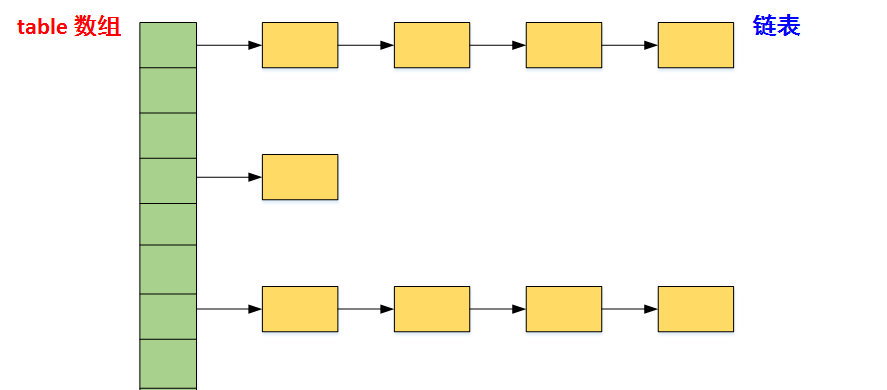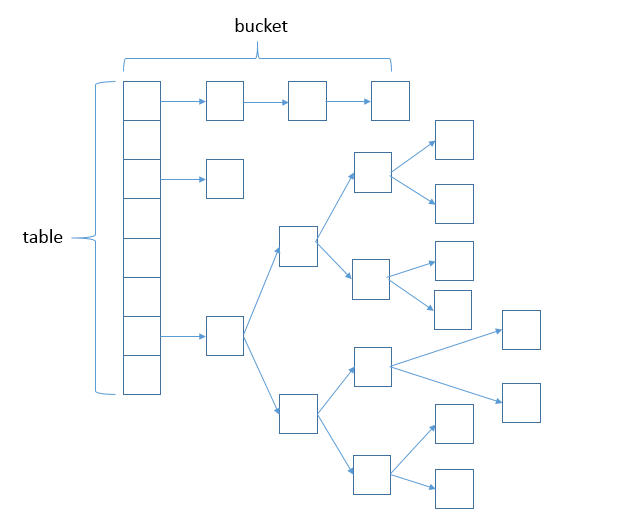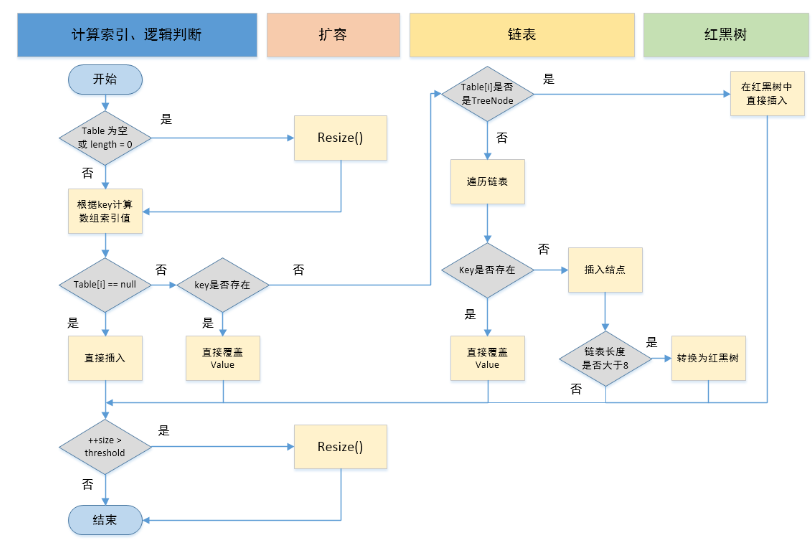JDK1.8 HashMap源码学习
HashMap
HashMap是开发中最常用的容器之一,它也是Java集合框架中极为重要的组成部分,HashMap实现了Map接口,并继承 AbstractMap 抽象类
public class HashMap<K,V> extends AbstractMap<K,V>
implements Map<K,V>, Cloneable, Serializable {
***
}首先了解下HashMap的几个字段
static final int DEFAULT_INITIAL_CAPACITY = 1 << 4; // 默认的初始容量
static final int MAXIMUM_CAPACITY = 1 << 30; //最大容量
static final float DEFAULT_LOAD_FACTOR = 0.75f; //默认负载因子
transient Node<K,V>[] table; //哈希桶数组
transient int size; //容器中键值对的个数
transient int modCount; //容器内部结构发生变化的次数,主要用于迭代的快速失败
int threshold; //阈值 table * loadFactor size超过这个值就会扩容
final float loadFactor; //负载因子 默认0.75Node的结构
static class Node<K,V> implements Map.Entry<K,V> {
final int hash;
final K key;
V value;
Node<K,V> next;
Node(int hash, K key, V value, Node<K,V> next) {
this.hash = hash;
this.key = key;
this.value = value;
this.next = next;
}
public final K getKey() { return key; }
public final V getValue() { return value; }
public final String toString() { return key + "=" + value; }
public final int hashCode() {
return Objects.hashCode(key) ^ Objects.hashCode(value);
}
public final V setValue(V newValue) {
V oldValue = value;
value = newValue;
return oldValue;
}
public final boolean equals(Object o) {
if (o == this)
return true;
if (o instanceof Map.Entry) {
Map.Entry<?,?> e = (Map.Entry<?,?>)o;
if (Objects.equals(key, e.getKey()) &&
Objects.equals(value, e.getValue()))
return true;
}
return false;
}
}Node(JDK1.8之前叫Entry)是HashMap的静态内部类,实现了Map.Entry接口,包括了hash,key,value和下一节点next四个属性,是构成哈希表的基石,是哈希表存储的元素的具体形式。
构造方法
public HashMap(int initialCapacity, float loadFactor) {
if (initialCapacity < 0)
throw new IllegalArgumentException("Illegal initial capacity: " +
initialCapacity);
if (initialCapacity > MAXIMUM_CAPACITY)
initialCapacity = MAXIMUM_CAPACITY;
if (loadFactor <= 0 || Float.isNaN(loadFactor))
throw new IllegalArgumentException("Illegal load factor: " +
loadFactor);
this.loadFactor = loadFactor;
this.threshold = tableSizeFor(initialCapacity);
}
=====================================================================
public HashMap(int initialCapacity) {
this(initialCapacity, DEFAULT_LOAD_FACTOR);
}
=====================================================================
public HashMap() {
this.loadFactor = DEFAULT_LOAD_FACTOR; // all other fields defaulted
}
=====================================================================
public HashMap(Map<? extends K, ? extends V> m) {
this.loadFactor = DEFAULT_LOAD_FACTOR;
putMapEntries(m, false);
}HashMap的初始容量和负载因子是影响map性能的关键参数,容量指的是table数组的大小,负载因子是衡量哈希表使用程度的一个尺度,负载因子越小,那哈希表空间的利用率就越低,造成的空间浪费就越严重。而如果负载因子越大,哈希表的利用率越高,带来的问题就是查找效率的下降。0.75是对空间和时间成本的折衷选择,一般情况下无需修改。
HashMap的数据结构
hash的概念:把任意长度的输入,通过hash算法,转换成相同长度的输出(通常为整型)。
HashMap的数据结构:
HashMap的底层数据结构结合了数组和链表(JDK1.8之前),实际上就是一个链表数组,也就是上文提到的Node<K,V> table[]。我们都知道数组的优势是查找快,增删慢,而链表则是增删快,查找慢,而这种链表数组——拉链法,结合了二者的优势,查找快,增删也快。查找元素的时间复杂度为O(1+n),n为链表的长度。在JDK1.8之后,为了解决哈希冲突频繁的问题,在原来的基础上又引入了红黑树,当链表长度超过8时,链表便会转化为红黑树结构,查找的时间复杂度从O(1+n)变成了O(1+lgn),大大提高了查询效率,不必再遍历链表。
JDK1.8之前的HashMap结构

JDK1.8的HashMap结构

HashMap的功能
HashMap中的方法很多,这里主要从hash,put,get,resize几个点深入研究
hash
static final int hash(Object key) {
int h;
return (key == null) ? 0 : (h = key.hashCode()) ^ (h >>> 16);
}首先,我们可以发现HashMap是允许null键的,而HashTable则不支持。
hash方法的本质是对key.hashCode()和key.hashCode()>>>16进行异或运算,>>>为无符号右移运算符,就是将补码右移后高位补0。^异或是参与运算的数每一位上的数字对比,相同结果为0,不同结果为1。
所以hash方法的功能就是对高16bit和低16bit进行异或运算来减少碰撞。
put方法
public V put(K key, V value) {
return putVal(hash(key), key, value, false, true);
}putVal方法
final V putVal(int hash, K key, V value, boolean onlyIfAbsent,
boolean evict) {
Node<K,V>[] tab; Node<K,V> p; int n, i;
//如果table为空或者为初始化则进行初始化
if ((tab = table) == null || (n = tab.length) == 0)
n = (tab = resize()).length;
//计算插入的索引值(n- 1) & hash,如果数组中这个索引位置为空 则直接插入,next指针指向为null
if ((p = tab[i = (n - 1) & hash]) == null)
tab[i] = newNode(hash, key, value, null);
else {
//如果key已经存在了,直接覆盖value
Node<K,V> e; K k;
if (p.hash == hash &&
((k = p.key) == key || (key != null && key.equals(k))))
//把第一个元素赋值给e记录
e = p;
//如果是红黑树
else if (p instanceof TreeNode)
//插入红黑树
e = ((TreeNode<K,V>)p).putTreeVal(this, tab, hash, key, value);
else {
//如果为链表,进行遍历直到下一个节点为null或者key存在
for (int binCount = 0; ; ++binCount) {
if ((e = p.next) == null) {
//插入链表最末端
p.next = newNode(hash, key, value, null);
//如果链表长度达到阈值 转换为红黑树
if (binCount >= TREEIFY_THRESHOLD - 1) // -1 for 1st
treeifyBin(tab, hash);
break;
}
//判断链表中的节点key与即将插入的key是否相同
if (e.hash == hash &&
((k = e.key) == key || (key != null && key.equals(k))))
break;
//和前面的e = p.next对应 用来遍历链表
p = e;
}
}
//如果key存在,则覆盖原来的value,返回oldValue
if (e != null) { // existing mapping for key
V oldValue = e.value;
if (!onlyIfAbsent || oldValue == null)
e.value = value;
//访问后的回调函数
afterNodeAccess(e);
return oldValue;
}
}
//记录结构修改
++modCount;
//如果哈希表中的键值对数量达到阈值,进行扩容
if (++size > threshold)
resize();
//插入后的回调函数
afterNodeInsertion(evict);
return null;
}流程梳理:
计算key的hash值 (h = key.hashCode() ^ h >>> 16)
根据hash值和table数组的长度n计算插入table数组的索引,(n - 1) & hash。由于n始终是2的n次方(为什么后面会介绍),所以(n - 1) & hash 相等于 hash % n ,但是位运算要比取模效率更高
多种情况
如果该位置没有数据,新生成一个节点保存新数据,返回null
如果该位置有数据且是红黑树结构,那么执行相应的插入 / 更新操作;
如果该位置有数据且是链表
- 该链表没有这个节点,采用尾插法新增节点保存新数据,返回null
- 链表上有这个节点,比较key.hash是否一致,一致则覆盖value,返回oldValue
流程图: 
get
public V get(Object key) {
Node<K,V> e;
return (e = getNode(hash(key), key)) == null ? null : e.value;
}
final Node<K,V> getNode(int hash, Object key) {
Node<K,V>[] tab; Node<K,V> first, e; int n; K k;
// 1. 定位键值对所在桶的位置
if ((tab = table) != null && (n = tab.length) > 0 &&
(first = tab[(n - 1) & hash]) != null) {
if (first.hash == hash && // always check first node
((k = first.key) == key || (key != null && key.equals(k))))
return first;
if ((e = first.next) != null) {
// 2. 如果 first 是 TreeNode 类型,则调用黑红树查找方法
if (first instanceof TreeNode)
return ((TreeNode<K,V>)first).getTreeNode(hash, key);
// 2. 对链表进行查找
do {
if (e.hash == hash &&
((k = e.key) == key || (key != null && key.equals(k))))
return e;
} while ((e = e.next) != null);
}
}
return null;
}resize
final Node<K,V>[] resize() {
//oldTable指向当前hash桶数组
Node<K,V>[] oldTab = table;
int oldCap = (oldTab == null) ? 0 : oldTab.length;
int oldThr = threshold;
int newCap, newThr = 0;
if (oldCap > 0) {//如果旧的hash桶不为空
if (oldCap >= MAXIMUM_CAPACITY) {
//如果大于最大容量,则阈值设置为最大整数的值
threshold = Integer.MAX_VALUE;
return oldTab;
}
else if ((newCap = oldCap << 1) < MAXIMUM_CAPACITY &&
oldCap >= DEFAULT_INITIAL_CAPACITY)
//如果旧的hash桶容量扩容一次(左移1位)后小于最大值,并且旧的桶容量大于默认值16
//新桶容量 = 旧桶容量*2
newThr = oldThr << 1; // double threshold
}
else if (oldThr > 0) // initial capacity was placed in threshold
newCap = oldThr;
else { // zero initial threshold signifies using defaults
//初始化
newCap = DEFAULT_INITIAL_CAPACITY;
newThr = (int)(DEFAULT_LOAD_FACTOR * DEFAULT_INITIAL_CAPACITY);
}
if (newThr == 0) {
float ft = (float)newCap * loadFactor;
newThr = (newCap < MAXIMUM_CAPACITY && ft < (float)MAXIMUM_CAPACITY ?
(int)ft : Integer.MAX_VALUE);
}
threshold = newThr;
@SuppressWarnings({"rawtypes","unchecked"})
//初始化一个容量为newCap的新hash桶数组
Node<K,V>[] newTab = (Node<K,V>[])new Node[newCap];
//将新桶复制给旧的hash桶数组
table = newTab;
if (oldTab != null) {
//如果旧的hash桶不为空,则开始扩容操作
for (int j = 0; j < oldCap; ++j) {
Node<K,V> e;
if ((e = oldTab[j]) != null) {//旧桶j处节点值赋值给e,如果不为空,将旧桶j节点设置为空
oldTab[j] = null;
if (e.next == null)//如果e后面没有节点
newTab[e.hash & (newCap - 1)] = e;//直接对e的hash值对新数组长度求模获得hash桶中存储位置
else if (e instanceof TreeNode)//如果e为红黑树节点,将e添加到红黑树中
((TreeNode<K,V>)e).split(this, newTab, j, oldCap);
else { // preserve order //如果是链表
Node<K,V> loHead = null, loTail = null;
Node<K,V> hiHead = null, hiTail = null;
Node<K,V> next;
do {
next = e.next;//将e的下一节点赋值给next
if ((e.hash & oldCap) == 0) {//如果e的hash值对旧桶长度求模为0
if (loTail == null)
loHead = e;//如果loTail为null,将e赋给loHead
else
loTail.next = e;//非则将e赋值给loTail的next节点
loTail = e;//将e赋值给loTail节点
}
else {//如果e的hash值对旧桶长度取模不为0
if (hiTail == null)
hiHead = e;//hiHead为null,将e赋值给hiHead
else
hiTail.next = e;//否则e赋值给hiTail.next
hiTail = e;//将e赋值给hiTail
}
} while ((e = next) != null);//直到e为空
if (loTail != null) {
//如果loTail不为空,将loTail的下一节点设置为null
loTail.next = null;
//将loHead赋值给新桶的j处
newTab[j] = loHead;
}
if (hiTail != null) {
//如果hiTail不为空,将hiTail的下一节点设置为null
hiTail.next = null;
//hiHead赋值给新桶的j+旧桶数组长度处
newTab[j + oldCap] = hiHead;
}
}
}
}
}
return newTab;
}为什么table的长度总是2的n次幂
- tableSizeFor(int cap)方法
static final int tableSizeFor(int cap) {
int n = cap - 1;
n |= n >>> 1;
n |= n >>> 2;
n |= n >>> 4;
n |= n >>> 8;
n |= n >>> 16;
return (n < 0) ? 1 : (n >= MAXIMUM_CAPACITY) ? MAXIMUM_CAPACITY : n + 1;
}测试类
public class Test {
public static void main(String[] args) {
int cap = 65538;
System.out.println(Integer.toBinaryString(cap));
System.out.println(Integer.toBinaryString(cap-1));
int i = tableSizeFor(cap);
System.out.println(Integer.toBinaryString(i));
}
static final int tableSizeFor(int cap) {
int n = cap - 1;
n |= n >>> 1;
System.out.println(Integer.toBinaryString(n));
n |= n >>> 2;
System.out.println(Integer.toBinaryString(n));
n |= n >>> 4;
System.out.println(Integer.toBinaryString(n));
n |= n >>> 8;
System.out.println(Integer.toBinaryString(n));
n |= n >>> 16;
System.out.println(Integer.toBinaryString(n));
return (n < 0) ? 1 : (n >= MAXIMUM_CAPACITY) ? MAXIMUM_CAPACITY : n + 1;
}
}运行结果
010000000000000010
010000000000000001
011000000000000001
011110000000000001
011111111000000001
011111111111111111
011111111111111111
100000000000000000- 分析 第一次运行: 10000000000000010 n >>> 1; 01000000000000000 进行|运算 11000000000000001 把最大位的1,通过位移后移一位,并且通过|运算,组合起来 第二次运行: 11000000000000001 n >>> 2; 00110000000000000 进行|运算 11110000000000001 把最大的两位,已经变成1的,往后移动两位,并且通过|运算,组合起来 第三次运行: 11110000000000001 n >>> 4; 00001111000000000 进行|运算 11111111000000001 把最大4位,已经变成1的,往后移动4位,并且通过|运算,组合起来 第四次运行: 11111111000000001 n >>> 8; 00000000111111110 进行|运算 11111111111111111 把最大的8位,已经变成1的,往后移动8位,并且通过|运算,组合起来 第五次运算: 同上进行16位运算 第六次运算: 返回结果,格式为最高位为1其他为全为0的值,即一定是2的整数次幂